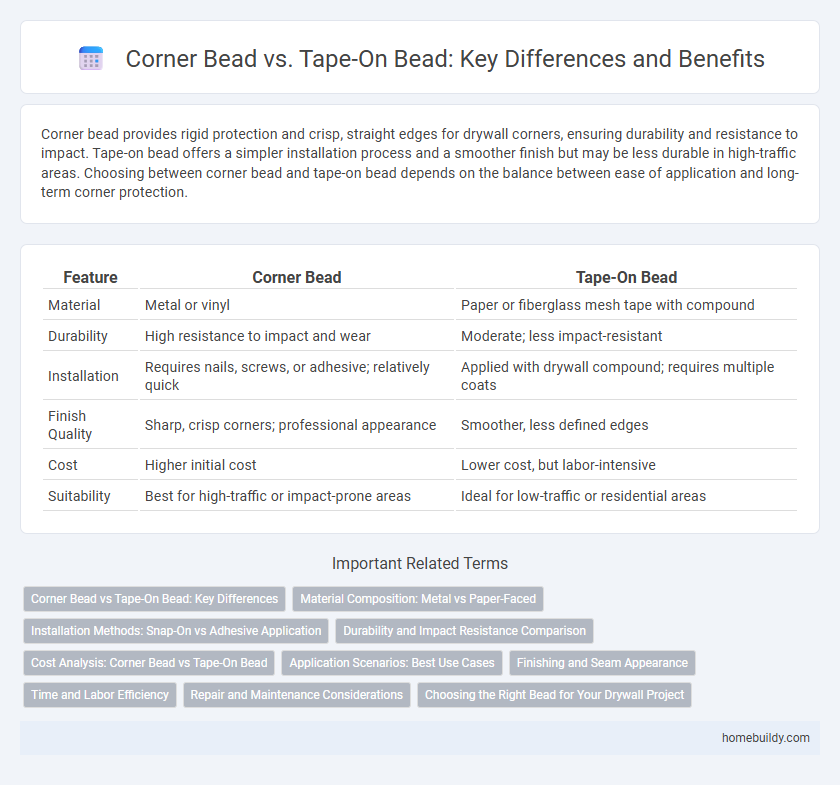Corner bead provides rigid protection and crisp, straight edges for drywall corners, ensuring durability and resistance to impact. Tape-on bead offers a simpler installation process and a smoother finish but may be less durable in high-traffic areas. Choosing between corner bead and tape-on bead depends on the balance between ease of application and long-term corner protection.
Table of Comparison
| Feature | Corner Bead | Tape-On Bead |
|---|---|---|
| Material | Metal or vinyl | Paper or fiberglass mesh tape with compound |
| Durability | High resistance to impact and wear | Moderate; less impact-resistant |
| Installation | Requires nails, screws, or adhesive; relatively quick | Applied with drywall compound; requires multiple coats |
| Finish Quality | Sharp, crisp corners; professional appearance | Smoother, less defined edges |
| Cost | Higher initial cost | Lower cost, but labor-intensive |
| Suitability | Best for high-traffic or impact-prone areas | Ideal for low-traffic or residential areas |
Corner Bead vs Tape-On Bead: Key Differences
Corner bead is a metal or plastic strip used to reinforce and create sharp, durable edges on drywall corners, offering superior impact resistance compared to tape-on bead, which relies on drywall tape embedded in joint compound for corner protection. Tape-on bead is easier to install and provides a smooth, finished look but lacks the strength and longevity that corner bead delivers, especially in high-traffic areas. Choosing between corner bead and tape-on bead depends on project requirements, with corner bead favored for durability and tape-on bead preferred for simpler, less impact-prone corners.
Material Composition: Metal vs Paper-Faced
Corner bead made from metal offers superior durability and impact resistance, ideal for high-traffic areas, while tape-on beads are typically paper-faced, providing a smoother finish and easier installation for less demanding applications. Metal corner beads, often galvanized steel or aluminum, resist dents and corrosion, making them suitable for commercial construction. Paper-faced tape-on beads combine a mesh backing with paper flanges, embedding seamlessly into drywall mud for a clean, crack-resistant surface.
Installation Methods: Snap-On vs Adhesive Application
Snap-on corner beads offer a mechanical fastening method, easily clipped onto metal or drywall corners for quick installation without drying time. Tape-on beads rely on adhesive backing applied directly to the corner, eliminating the need for nails or screws but requiring precise alignment and drying time. Each method affects installation speed, durability, and finishing quality, with snap-on providing a sturdy hold and tape-on delivering a seamless, less intrusive finish.
Durability and Impact Resistance Comparison
Corner bead offers superior durability and impact resistance compared to tape-on bead due to its rigid metal or vinyl material that reinforces drywall corners effectively. Tape-on bead, typically made from paper or mesh, provides less protection against heavy impacts and may wear down faster over time. Metal corner bead resists dents and cracks, making it ideal for high-traffic areas where long-lasting corner reinforcement is essential.
Cost Analysis: Corner Bead vs Tape-On Bead
Corner bead typically incurs higher upfront costs due to materials like metal or rigid plastic and installation labor, whereas tape-on bead offers a more budget-friendly alternative with lower material expenses and faster application time. Tape-on bead reduces labor costs by simplifying the finishing process, making it ideal for large-scale drywall projects aiming to minimize overhead. Considering durability and maintenance, corner bead may lead to long-term savings despite initial expenses, while tape-on bead excels in cost-efficiency for shorter-term or less demanding environments.
Application Scenarios: Best Use Cases
Corner bead is ideal for external corners exposed to high traffic or physical impact, providing durable protection and maintaining sharp edge definition. Tape-on bead suits interior corners with low impact, offering faster installation and a smooth finish on drywall surfaces. For heavy-duty finishes such as commercial buildings or high-traffic corridors, metal or vinyl corner beads outperform tape-on options.
Finishing and Seam Appearance
Corner bead provides a crisp, durable edge that enhances seam appearance by preventing cracks and chips along drywall corners, creating a clean and professional finish. Tape-on bead offers a smoother, more subtle transition with easy blending into surrounding surfaces, ideal for minimizing visible joints in finished walls. Choosing between corner bead and tape-on bead depends on desired texture durability and the level of seamless finish needed for the specific project.
Time and Labor Efficiency
Corner bead significantly reduces installation time compared to tape-on bead due to its ready-made shape that easily snaps onto drywall corners, eliminating the need for multiple layers of joint compound. The pre-formed design minimizes labor intensity and ensures faster finishing, allowing workers to complete projects more efficiently. This streamlined process not only accelerates drywall installations but also improves overall productivity on construction sites.
Repair and Maintenance Considerations
Corner bead offers superior durability and impact resistance compared to tape-on bead, making it ideal for areas prone to frequent damage and repairs. Repairing corner bead involves replacing or straightening the metal or plastic strip, which, though more labor-intensive, ensures long-term structural integrity. Tape-on bead repairs are simpler but less durable, often requiring repeated maintenance and frequent touch-ups.
Choosing the Right Bead for Your Drywall Project
Corner bead offers greater durability and impact resistance compared to tape-on bead, making it ideal for high-traffic areas or corners prone to damage. Tape-on bead provides a smoother finish and is easier to install, suitable for straight, light-use corners and DIY projects. Evaluating project needs, such as expected wear and desired finish, helps determine the optimal choice between corner bead and tape-on bead for drywall applications.
corner bead vs tape-on bead Infographic

 homebuildy.com
homebuildy.com